High Impact Tutoring Built By Math Experts
Personalized standards-aligned one-on-one math tutoring for schools and districts
Conversion of measurement units
Here you will learn about the conversion of units including conversions between metric units and between customary units.
Students will first learn about conversion of measurement as part of measurement and data in 5th grade.
What is the conversion of measurement units?
The conversion of measurement units is taking a given unit, such as a length, capacity, mass or time and showing the same measurement with a different unit.
For example,
How many minutes are in 2 hours?
Hours is a measurement of time.
| Conversion of Measurement Units for Time | |
| 1 minute | 60 seconds |
| 1 hour | 60 minutes |
| 1 day | 24 hours |
| 1 week | 7 days |
| 1 year | 365 days |
Using the relationship between each, you can convert between the units of time.
Since there are 60 minutes in 1 hour, there are 120 minutes in 2 hours.
\quad 60 minutes ( 1 hour)
+ \;\, \underline{60} minutes ( \underline{1} hour)
\;\; 120 minutes ( 2 hours)
Each measurement system has their own conversion factors.
- The metric system is based on powers of 10. It is considered the International system of units (SI) - SI units. The prefixes that come before the SI base units, such as kilo, centi, deci and milli, are used to indicate which power of 10 is involved.
For example,
\begin{aligned}& 1 \mathrm{~km}=1000 \mathrm{~m} \\\\ & 1 \mathrm{~m}=100 \mathrm{~cm} \\\\ & 1\mathrm{~kg}=1000 \mathrm{~g} \\\\ & 1 \mathrm{~cl}=10 \mathrm{~ml}\end{aligned}
- The customary system is an older system of measurements, but it is still used in some places. The customary units are NOT based on powers of 10.
For example,
\begin{aligned}& 1 \text { foot }=12 \text { inches } \\\\ & 3 \text { feet }=1 \text { yard } \\\\ & 1,760 \text { yards }=1 \text { mile }\end{aligned}
For both systems, you can convert units of measurement using conversion factors.
The conversion factor is a number you multiply or divide by to change units.
For example,
Below are the conversion factors for meters.
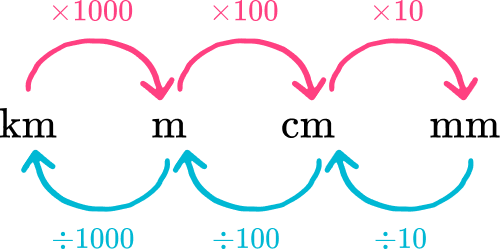
Convert 400 centimeters into meters.
There are 100 \, cm in 1 \, m. This is the conversion factor. To convert from cm to m you need to divide.
So, 400 \mathrm{~cm} \div 100=4 \mathrm{~m}.
For example,
Below are the conversion factors for capacity (volume) in the customary system.

Convert 9 quarts into pints.
There are 2 \text { pints } in 1 \text { quart }. This is the conversion factor. To convert from quarts to pints , you need to multiply.
So, 9 \text { quarts } \times 2=18 \text { pints }.
You can also use unit conversions for time.
For example,

How many minutes are there in 5 hours?
There are 60 minutes in 1 hour.
So, 5 \text { hours } \times 60=300 \text { minutes }.
What is the conversion of measurement units?
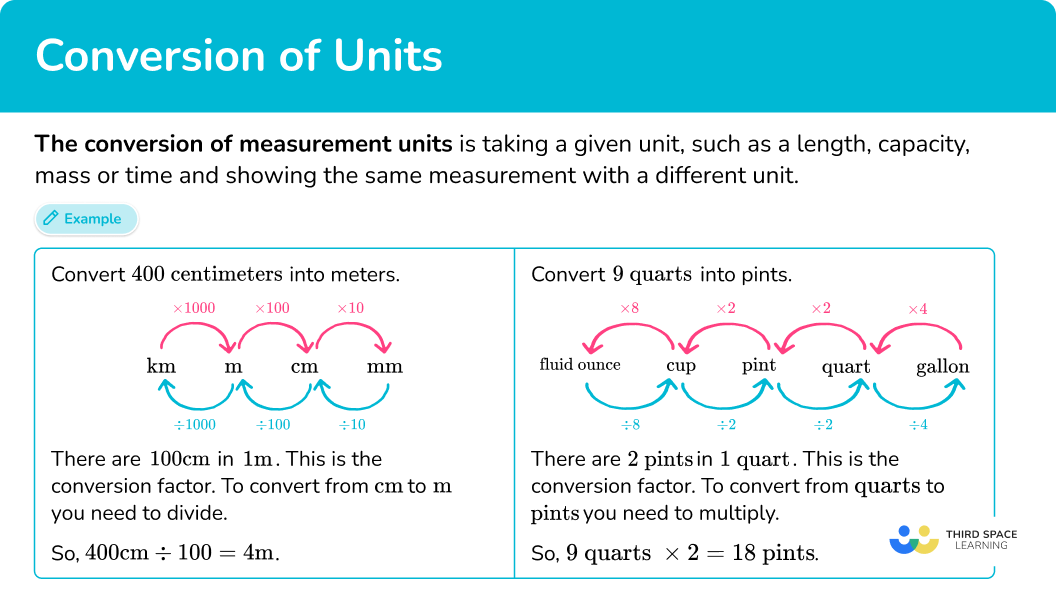
Common Core State Standards
How does this relate to 5 th grade math?
- Grade 5 – Measurement and Data (5.MD.A.1)
Convert among different-sized standard measurement units within a given measurement system (For example, convert 5 \, cm to 0.05 \, m ), and use these conversions in solving multi-step, real world problems.
How to convert measurement units
In order to convert measurement units:
- Find the conversion factor.
- Multiply or divide by the conversion factor.
- Write down the answer.
![[FREE] Units of Measurement Check for Understanding (Grade 4 to 5)](https://thirdspacelearning.com/wp-content/uploads/2023/10/Units-of-Measurement-listing-image.png)
[FREE] Units of Measurement Check for Understanding (Grade 4 to 5)
![[FREE] Units of Measurement Check for Understanding (Grade 4 to 5)](https://thirdspacelearning.com/wp-content/uploads/2023/10/Units-of-Measurement-listing-image.png)
Use this quiz to check your grade 4 to 5 students’ understanding of units of measurement. 10+ questions with answers covering a range of 4th and 5th grade units of measurement topics to identify areas of strength and support!
DOWNLOAD FREE![[FREE] Units of Measurement Check for Understanding (Grade 4 to 5)](https://thirdspacelearning.com/wp-content/uploads/2023/10/Units-of-Measurement-listing-image.png)
[FREE] Units of Measurement Check for Understanding (Grade 4 to 5)
![[FREE] Units of Measurement Check for Understanding (Grade 4 to 5)](https://thirdspacelearning.com/wp-content/uploads/2023/10/Units-of-Measurement-listing-image.png)
Use this quiz to check your grade 4 to 5 students’ understanding of units of measurement. 10+ questions with answers covering a range of 4th and 5th grade units of measurement topics to identify areas of strength and support!
DOWNLOAD FREEConversion of units examples
Example 1: converting units of time
Convert 2 minutes to seconds.
- Find the conversion factor.
Since seconds is the desired unit, you need the conversion factor between minutes and seconds:
1 \text { minute }=60 \text { seconds }
The conversion factor for minutes and seconds is 60.
2Multiply or divide by the conversion factor.
Look at the relationship in the original conversion.
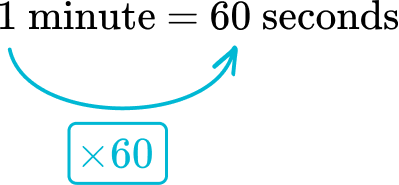
From minutes to seconds, the relationship is multiplying by 60.
Multiply 2 minutes by 60 :
2 \times 60=120 \text { seconds }
3Write down the answer.
2 \text { minutes }=120 \text { seconds }
Example 2: converting units of length
Convert 180 inches to feet.
Find the conversion factor.
Since feet is the desired unit, you need the conversion factor between inches and feet:
1 \text { foot }=12 \text { inches }
The conversion factor for inches and feet is 12.
Multiply or divide by the conversion factor.
Look at the relationship in the original conversion.
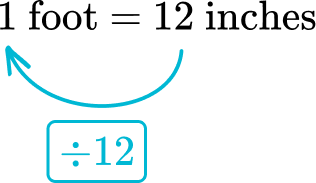
From inches to feet, the relationship is dividing by 12.
Divide 180 inches by 12 :
180 \div 12=15 \text { feet }
Write down the answer.
180 \text { inches }= 15 \text { feet }
Example 3: converting units of capacity
Convert 2.5 liters to milliliters.
Find the conversion factor.
Since milliliters is the desired unit, you need the conversion factor between liters and milliliters:
1 \text { liter }=1,000 \text { milliliters }
The conversion factor for liters and milliliters is 1,000.
Multiply or divide by the conversion factor.
Look at the relationship in the original conversion.
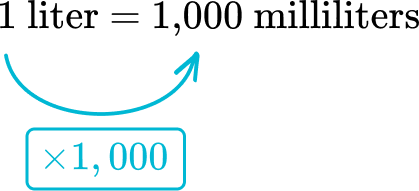
From liters to milliliters, the relationship is multiplying by 1,000.
Multiply 2.5 liters by 1,000 :
2.5 \times 1,000=2,500 \text { milliliters }
Write down the answer.
2.5 \text { liters }=2,500 \text { milliliters }
Example 4: converting units of mass
Convert 7 kilograms to milligrams.
Find the conversion factor.
1 \text { kilogram }=1,000,000 \text { milligrams }
The conversion factor for kilograms to milligrams is 1,000,000.
Multiply or divide by the conversion factor.
Look at the relationship in the original conversion.

From kilograms to milligrams, the relationship is multiplying by 1,000,000.
Multiply 7 kilograms by 1,000,000 :
7 \times 1,000,000=7,000,000 \text { milligrams }
Write down the answer.
7 \text { kilograms }=7,000,000 \text { milligrams }
Example 5: converting units of time
Convert 9,000 seconds to hours.
Find the conversion factor.
60 \text { seconds }=1 \text { minute } \quad and \quad 60 \text { minutes }= 1 \text { hour }
The conversion factor for minutes and seconds is 60 , and the conversion factor for minutes and hours is 60.
Multiply or divide by the conversion factor.
Look at the relationship in the original conversions.
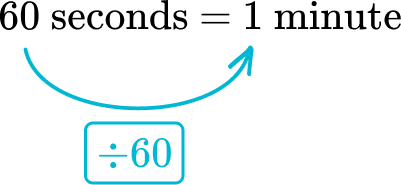
From seconds to minutes, the relationship is dividing by 60.
Divide 9,000 seconds by 60 :
9,000 \div 60=150 \text { minutes }
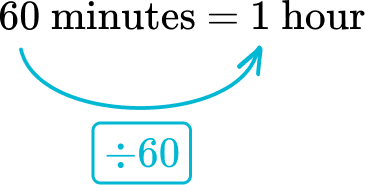
From minutes to hours, the relationship is dividing by 60.
Divide 150 minutes by 60 :
150 \div 60=2.5 \text { hours }
Write down the answer.
9,000 \text { seconds }=2.5 \text { hours }
Example 6: converting units of length
Convert 230 meters to kilometers.
Find the conversion factor.
1 \text { kilometer }=1,000 \text { meters }
The conversion factor for meters and kilometers is 1,000.
Multiply or divide by the conversion factor.
Look at the relationship in the original conversion.
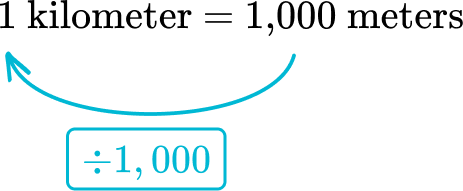
From meters to kilometers, the relationship is dividing by 1,000.
Divide 230 meters by 1,000 :
230 \div 1,000=0.23 \text { kilometers }
Write down the answer.
230 \text { meters }=0.23 \text { kilometers }
Teaching tips for conversion of measurement units
- Worksheets with a conversion table are a good way for students to practice converting measurements. Providing the table allows students to focus on the relationship instead of trying to remember the conversion rates.
- Give students opportunities to measure items around the classroom or school. This includes having them measure the same item in different units (like a desk in mm, cm and m ) or an amount of water in ml and l. This helps students understand that converting measurements doesn’t change the actual amount, it just changes the way it is measured.
- If students are really struggling, let them use a conversion calculator or unit converter, but require them to explain the conversion and the calculations that were made. With time, once they have seen enough examples, they can begin to solve problems without the additional assistance.
Easy mistakes to make
- Fractions of an hour
Remember that time is not base 10. A quarter as a fraction is \cfrac{1}{4} and as a decimal is 0.25, but a quarter of an hour is 15 minutes.
For example,
3.5 hours is 3 hours and 30 minutes.
1 \cfrac{1}{2} days is 1 day and 12 hours.
- Confusing when to multiply and divide
Converting from a larger unit to a smaller unit (like meter to centimeter) is done by multiplying by 100. This can be confusing since going from larger to small units is done by multiplying. Always stop and think about the conversion before deciding which operation to use.
- Using the conversion factor to add or subtract
The relationship between units is multiplicative, which is why conversions are done in multiplication and division. Using addition or subtraction will lead to the incorrect answer.
- Thinking the conversion factor of area is the one dimensional factor
Area is a two-dimensional measurement and therefore does not convert in the same way as one-dimensional measurements.
For example,
1 \text { meter }=100 \text { centimeters}, but 1 \text { square meter }≠ 100 \text { square centimeters }
1 \text { yard }=3 \text { feet }, but 1 \text { square yard }≠ 3 \text { square feet }
- Thinking the conversion factor of volume is the one dimensional factor
Volume is a three-dimensional measurement and therefore does not convert in the same way as one-dimensional measurements.
For example,
1 \text { meter }=100 \text { centimeters}, but 1 \text { cubic meter }≠ 100 \text { cubic centimeters }
1\text { foot }=12 \text { inches }, but 1 \text { cubic foot }≠ 12 \text { cubic inches }
Related units of measurement lessons
Practice conversion of units questions
1. Convert 4.5 \, minutes to seconds\text{:}




The conversion factor between \text{minutes} and \text{seconds:}
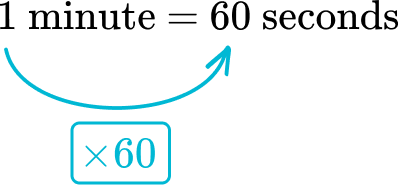
Multiply 4.5 \text{ minutes} by 60 :
4.5 \times 60=270 \text { seconds }
4.5 \text { minutes }=270 \text { seconds }
2. Convert 144 \, \text{ounces} to pounds\text{:}




The conversion factor between \text{ounces} and \text{pounds:}
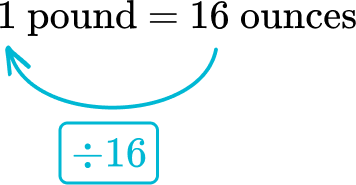
Divide 144 \, minutes by 16 :
144 \div 16=9 \text { pounds }
144 \text { ounces }=9 \text { pounds }
3. Convert 3,400 \, km to m\text{:}




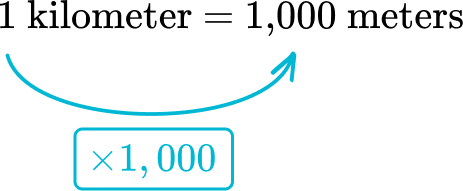
Multiply 3,400 \, kilometers by 1,000 :
3,400 \times 1,000=3,400,000 \text { meters }
3,400 \text { kilometers }=3,400,000 \text { meters }
4. Convert 5 \, \text{gallons} to \text{cups:}




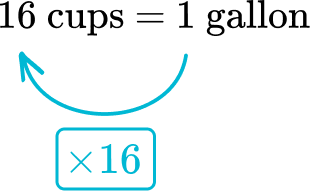
Multiply 5 \, \text{gallons} by 16 :
5 \times 16=80 \, \mathrm{cups}
5 \text { gallons }=80 \text { cups }
5. Convert 2,560 \, \text{milliliters} to \text{liter:}




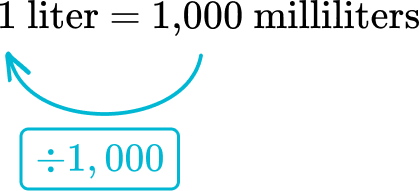
Divide 2,560 \, \text{milliliters} by 1,000 :
2,560 \div 1,000=2.56 \text { liters }
2,560 \text { milliliters }=2.56 \text { liters }
6. Convert 5 \, \text{hours} to \text{seconds:}




The conversion factor between \text{hours} and \text{minutes:}
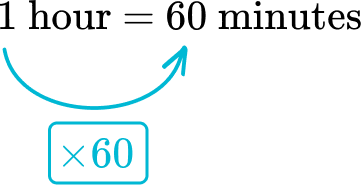
Multiply 5 \, hours by 60 :
5 \times 60=300 \text { minutes }
The conversion factor between \text{minutes} and \text{seconds:}
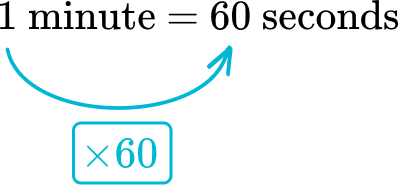
Multiply 300 \, \text{minutes} by 60 :
300 \times 60=18,000 \text { seconds }
5 \text { hours }=18,000 \text { seconds }
Conversion of measurement units FAQs
It is a shorthand way to write very large or small numbers based on their power of 10.
Fahrenheit is a measurement of temperature. Celsius is another commonly used temperature measurement. The conversion between them is more complicated than the examples shown on this page. The formula used to convert between them is F=C \times \cfrac{9}{5}+32.
The next lessons are
- Represent and interpret data
- Ratio
- Proportion
Still stuck?
At Third Space Learning, we specialize in helping teachers and school leaders to provide personalized math support for more of their students through high-quality, online one-on-one math tutoring delivered by subject experts.
Each week, our tutors support thousands of students who are at risk of not meeting their grade-level expectations, and help accelerate their progress and boost their confidence.

Find out how we can help your students achieve success with our math tutoring programs.
[FREE] Common Core Practice Tests (3rd to 8th Grade)
Prepare for math tests in your state with these 3rd Grade to 8th Grade practice assessments for Common Core and state equivalents.
Get your 6 multiple choice practice tests with detailed answers to support test prep, created by US math teachers for US math teachers!